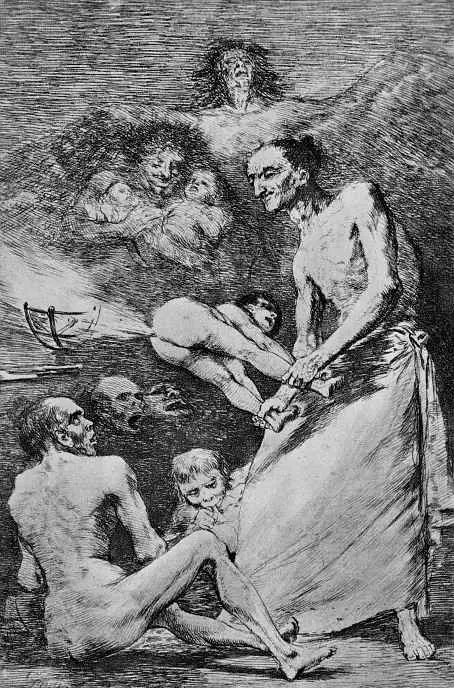log in
Enter site
Login to use Arthive functionality to the maximum
A series of "Caprichos", page 69: Er
Francisco Goya • Grafik, 1799, 21.5×15 cm


















Beschreibung des Kunstwerks «A series of "Caprichos", page 69: Er»
The creative legacy of the famous genius of Spain, Francisco Goya more than two centuries attracted scientists and ordinary art lovers. The first attempts of scientific disclosure difficult, dramatic essence of the artist's works made in the mid-nineteenth century. And since the volume of research continually growing, now the number of articles, specialized books, albums about Goya calculate the hundreds of titles. In the paintings of Goya "Caprichos"and in his other works, the artist managed to develop his own style of creativity, which is different from the classic manner of the painters of the XVIII-XIX centuries and contrasts with it so much that his paintings some art historians have regarded as precursors of impressionism.
"Caprichos" by the great Francisco Goya is a well – known series of etchings by the Spanish artist, which is a satire on the social, political, religious orders. In addition, fantastic creatures, which depicts Goya at numerous engravings not only make unrealistic interpretation of the number of subjects, but to destroy the border between the critical eye of the master on the way society and the unreal perception of the earthly world by the Creator with a sick mentality. Etchings "Caprichos" Goya became one of his first works, which reflects the impact of the disease of the master. A number of scientists believed that the series was created by Goya in an altered mental state, in which the main role played by anxiety, frequent depression, mechanisms of inhibition. The whole series was completed by 1799, the graphic Series "Caprichos" Goya consists of 80 works.
The most famous work of this series is etching No. 43, which had a symbolic name "the Sleep of reason produces monsters". While the Mind is resting, the dream world gives countless troubles, creating a special climate, specific atmosphere of painful nightmares of the absurdity. Even more: until the Mind, being idle, sleeping, Interzum is in a state of wakefulness. Besides, he reshapes with his usual arrogance the world according to their understanding, destroying people are all human, turning them into "antilogy": evil sorcerers, witches, and other evil spirits. To Mind in the end jumped up from sleep, he needs to feel the outrage, the desire for action at the sight of those excesses, what he is doing around Interzum.
In his series "Caprichos" of Francisco Goya, referring to the images of folk tales, based on the Proverbs of Spain, subjected to ridicule human prejudices, exposes the hypocrisy, pretense, cruelty, and other vices. In fact, he condemns the very traditional structure of Spain at the time. In the etchings of Goya reality is intertwined with fantasy, and the grotesque becomes a caricature. Each part of this series is a complete work, consisting of drawing with the comment of the author.
In 1815 the artist begins to work on the next series of drawings — "Disparates" (translated as "extravagance, folly"), which is themed like the great paintings of Goya's Caprichos, but even more difficult for interpretation and understanding.
"Caprichos" by the great Francisco Goya is a well – known series of etchings by the Spanish artist, which is a satire on the social, political, religious orders. In addition, fantastic creatures, which depicts Goya at numerous engravings not only make unrealistic interpretation of the number of subjects, but to destroy the border between the critical eye of the master on the way society and the unreal perception of the earthly world by the Creator with a sick mentality. Etchings "Caprichos" Goya became one of his first works, which reflects the impact of the disease of the master. A number of scientists believed that the series was created by Goya in an altered mental state, in which the main role played by anxiety, frequent depression, mechanisms of inhibition. The whole series was completed by 1799, the graphic Series "Caprichos" Goya consists of 80 works.
The most famous work of this series is etching No. 43, which had a symbolic name "the Sleep of reason produces monsters". While the Mind is resting, the dream world gives countless troubles, creating a special climate, specific atmosphere of painful nightmares of the absurdity. Even more: until the Mind, being idle, sleeping, Interzum is in a state of wakefulness. Besides, he reshapes with his usual arrogance the world according to their understanding, destroying people are all human, turning them into "antilogy": evil sorcerers, witches, and other evil spirits. To Mind in the end jumped up from sleep, he needs to feel the outrage, the desire for action at the sight of those excesses, what he is doing around Interzum.
In his series "Caprichos" of Francisco Goya, referring to the images of folk tales, based on the Proverbs of Spain, subjected to ridicule human prejudices, exposes the hypocrisy, pretense, cruelty, and other vices. In fact, he condemns the very traditional structure of Spain at the time. In the etchings of Goya reality is intertwined with fantasy, and the grotesque becomes a caricature. Each part of this series is a complete work, consisting of drawing with the comment of the author.
In 1815 the artist begins to work on the next series of drawings — "Disparates" (translated as "extravagance, folly"), which is themed like the great paintings of Goya's Caprichos, but even more difficult for interpretation and understanding.
Veröffentlichungen zum Kunstwerk



